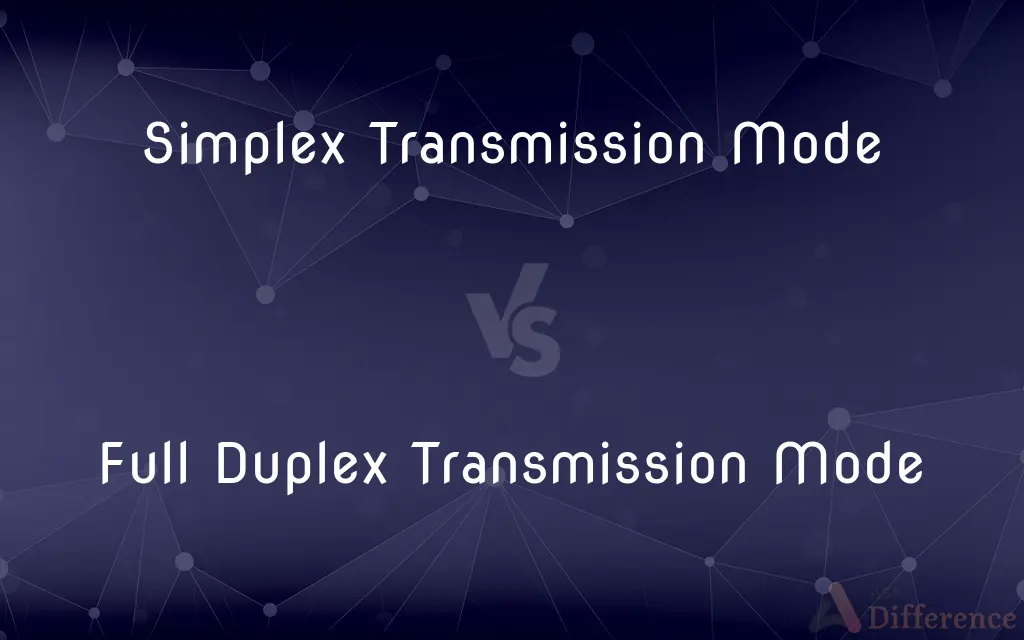Simplex Transmission Mode vs. Full Duplex Transmission Mode — What's the Difference?
By Tayyaba Rehman & Fiza Rafique — Published on January 30, 2024
Simplex Transmission Mode allows communication in one direction only, like a radio broadcast, while Full Duplex Transmission Mode enables simultaneous two-way communication, like a telephone call.

Difference Between Simplex Transmission Mode and Full Duplex Transmission Mode
Table of Contents
ADVERTISEMENT
Key Differences
Simplex Transmission Mode allows data to be sent in only one direction, whereas Full Duplex Transmission Mode enables simultaneous two-way data transmission. This distinction makes Simplex suitable for applications like broadcasting, while Full Duplex excels in interactive communication.
In Simplex Transmission Mode, one device is strictly a sender and the other a receiver, unlike Full Duplex Transmission Mode, where both devices can send and receive data concurrently. This creates a fundamental difference in how communication systems are designed and utilized.
The inability of Simplex Transmission Mode to handle two-way communication simultaneously is a stark contrast to Full Duplex Transmission Mode, which allows for a more dynamic and interactive exchange of information, enhancing efficiency in many communication scenarios.
Full Duplex Transmission Mode, with its simultaneous send-receive capability, is more complex and often more expensive to implement than Simplex Transmission Mode, which is simpler and typically used in scenarios where only one-way communication is required.
The application areas of Simplex Transmission Mode, like radio broadcasts, differ significantly from those of Full Duplex Transmission Mode, which is common in telephone networks, highlighting their different roles in communication technology.
ADVERTISEMENT
Comparison Chart
Communication Direction
One-way only
Two-way, simultaneous
Interaction
Non-interactive
Interactive
Use Cases
Broadcasting, alarms
Phone calls, online meetings
Hardware Complexity
Simpler hardware
More complex hardware
Efficiency in Usage
Efficient for specific purposes
More efficient for interactive needs
Compare with Definitions
Simplex Transmission Mode
Best suited for specific tasks where two-way communication is unnecessary.
Museum audio guides often work on simplex transmission for one-way information delivery.
Full Duplex Transmission Mode
Allows simultaneous sending and receiving of data.
Our office's intercom system works on full duplex mode for instant two-way conversation.
Simplex Transmission Mode
Lacks the capability for receiving feedback.
The public address system operates in simplex mode, only broadcasting announcements.
Full Duplex Transmission Mode
Offers greater throughput for communication systems.
The internet's full duplex mode enables high-speed data transfer in both directions.
Simplex Transmission Mode
Requires less complex hardware compared to two-way systems.
The fire alarm, a simplex device, needs minimal hardware to operate.
Full Duplex Transmission Mode
Requires more sophisticated hardware for simultaneous transmission.
Smartphones use full duplex transmission, requiring advanced circuitry.
Simplex Transmission Mode
Transmits data in a single direction.
Our security alarm uses simplex transmission to send alerts.
Full Duplex Transmission Mode
Ensures more efficient and effective communication.
Video conferencing uses full duplex mode for seamless, real-time discussion.
Simplex Transmission Mode
Ideal for mass broadcasting where feedback isn't required.
Television channels utilize simplex transmission to broadcast their programs.
Full Duplex Transmission Mode
Suitable for interactive communication needs.
Full duplex transmission is essential for our customer support hotline to function effectively.
Common Curiosities
What are the hardware requirements for Simplex Transmission Mode?
It requires simpler hardware compared to full duplex systems.
Do smartphones use Full Duplex Transmission Mode?
Yes, smartphones utilize full duplex for simultaneous talk and listen functionality.
Where is Simplex Transmission Mode commonly used?
It's used in broadcasting, like radio and TV transmissions.
Is Simplex Transmission Mode less efficient than Full Duplex?
It's less versatile but can be efficient for its specific one-way communication purposes.
What is Full Duplex Transmission Mode?
A communication mode allowing simultaneous two-way data transmission.
How does Full Duplex Transmission Mode benefit communication?
It enables interactive and efficient communication, like in telephones.
Is Simplex Transmission Mode suitable for interactive applications?
No, it's not suitable for interactions as it only supports one-way communication.
Can Full Duplex Transmission Mode be used for broadcasting?
While possible, it's not typically used for broadcasting due to its two-way nature.
Does Full Duplex Transmission Mode require more bandwidth?
It may require more bandwidth to handle simultaneous transmission and reception.
What is Simplex Transmission Mode?
It's a communication mode where data is transmitted in one direction only.
Can Simplex Transmission Mode be converted to Full Duplex?
Not directly; it requires significant hardware and protocol changes.
Is Simplex Transmission Mode outdated?
Not necessarily; it's still relevant for specific applications like broadcasting.
Are internet communications typically Full Duplex?
Yes, most internet communications use full duplex for efficient data exchange.
How does Full Duplex Transmission Mode impact online meetings?
It allows for smooth, real-time conversation without transmission delays.
Can Simplex and Full Duplex Modes be used in the same network?
Yes, but they serve different purposes and functionalities within the network.
Share Your Discovery

Previous Comparison
Minecraft vs. Real Life
Next Comparison
Male Blue Crabs vs. Female Blue CrabsAuthor Spotlight
Written by
Tayyaba RehmanTayyaba Rehman is a distinguished writer, currently serving as a primary contributor to askdifference.com. As a researcher in semantics and etymology, Tayyaba's passion for the complexity of languages and their distinctions has found a perfect home on the platform. Tayyaba delves into the intricacies of language, distinguishing between commonly confused words and phrases, thereby providing clarity for readers worldwide.
Co-written by
Fiza RafiqueFiza Rafique is a skilled content writer at AskDifference.com, where she meticulously refines and enhances written pieces. Drawing from her vast editorial expertise, Fiza ensures clarity, accuracy, and precision in every article. Passionate about language, she continually seeks to elevate the quality of content for readers worldwide.












































